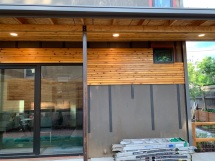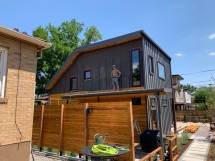We are now 99% done with house facade. The install of the cedar rainscreen system complements the previously installed standing seam metal siding. The two-month effort involved myself staining wood during the week and Scott, with the help of a friend and our brother-in-law, who spent the weekends installing it. We selected cedar wood because it lasts well against the elements in Colorado and the stain we used was the PPG (formerly Sikkens) SRD Wood Finish Transparent Matte in the Natural Wood color. We stained all sides before install that should hold up for 5-7 years, at which point we would re-stain the front exposed face.
The rainscreen system is a different cladding approach to the standing seam metal siding that is on the south and north facades of the house. The metal standing seam material works well for what is called a wall-barrier system approach which basically eliminates the possibility of water, vapor or air from ever coming in contact with our SIP panels. Assuming that install is meticulous and ensures tight seams between panels; the metal siding is essentially impermeable (for this approach you most likely wouldn’t use wood which is permeable). We especially liked using metal material on the South facade because it will hold up to direct sun exposure throughout the year.
Contrary to the wall-barrier approach, the rainscreen system that we used on the East and West faces of the house is designed to allow water, vapor and air to come in contact with the exterior wall (SIP Panel). When designed and installed correctly, the rainscreen controls and directs moisture. Together with proper ventilation, this method will prevent water from accumulating; allowing it to either dry out or evacuate the system.
Below are images that exhibit the system. The 1/8th inch spacing between cedar boards and the air gap between the house and the cedar screen controls the flow of water, vapor, and air. With the spacing between cedar planks and the air gap behind the screen, water is able to evacuate while air and vapor help to dry it out.






















